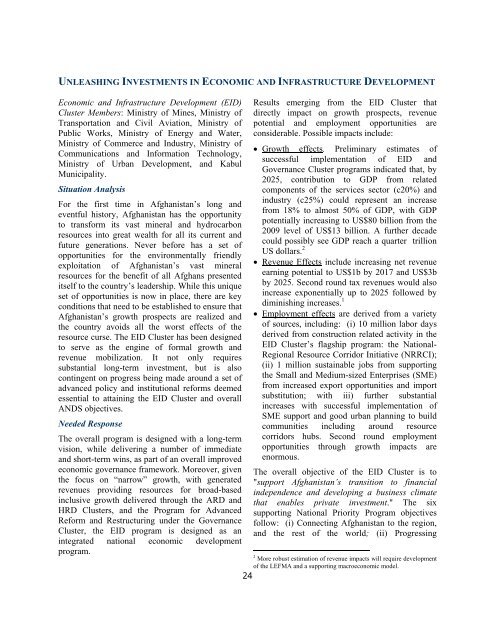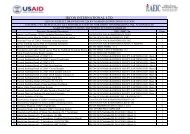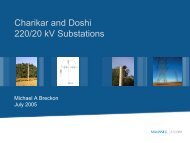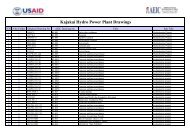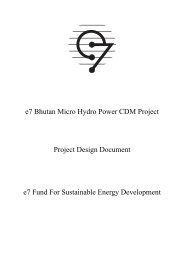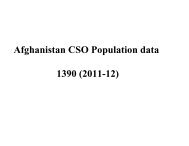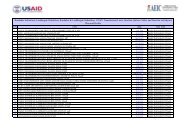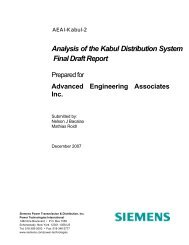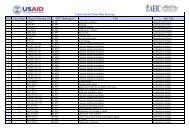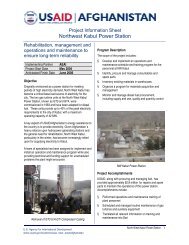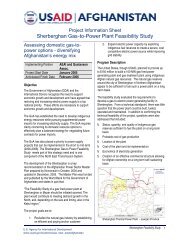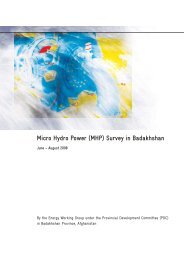prioritization and implementation plan - Cooperazione Italiana allo ...
prioritization and implementation plan - Cooperazione Italiana allo ...
prioritization and implementation plan - Cooperazione Italiana allo ...
Create successful ePaper yourself
Turn your PDF publications into a flip-book with our unique Google optimized e-Paper software.
UNLEASHING INVESTMENTS IN ECONOMIC AND INFRASTRUCTURE DEVELOPMENT<br />
Economic <strong>and</strong> Infrastructure Development (EID)<br />
Cluster Members: Ministry of Mines, Ministry of<br />
Transportation <strong>and</strong> Civil Aviation, Ministry of<br />
Public Works, Ministry of Energy <strong>and</strong> Water,<br />
Ministry of Commerce <strong>and</strong> Industry, Ministry of<br />
Communications <strong>and</strong> Information Technology,<br />
Ministry of Urban Development, <strong>and</strong> Kabul<br />
Municipality.<br />
Situation Analysis<br />
For the first time in Afghanistan’s long <strong>and</strong><br />
eventful history, Afghanistan has the opportunity<br />
to transform its vast mineral <strong>and</strong> hydrocarbon<br />
resources into great wealth for all its current <strong>and</strong><br />
future generations. Never before has a set of<br />
opportunities for the environmentally friendly<br />
exploitation of Afghanistan’s vast mineral<br />
resources for the benefit of all Afghans presented<br />
itself to the country’s leadership. While this unique<br />
set of opportunities is now in place, there are key<br />
conditions that need to be established to ensure that<br />
Afghanistan’s growth prospects are realized <strong>and</strong><br />
the country avoids all the worst effects of the<br />
resource curse. The EID Cluster has been designed<br />
to serve as the engine of formal growth <strong>and</strong><br />
revenue mobilization. It not only requires<br />
substantial long-term investment, but is also<br />
contingent on progress being made around a set of<br />
advanced policy <strong>and</strong> institutional reforms deemed<br />
essential to attaining the EID Cluster <strong>and</strong> overall<br />
ANDS objectives.<br />
Needed Response<br />
The overall program is designed with a long-term<br />
vision, while delivering a number of immediate<br />
<strong>and</strong> short-term wins, as part of an overall improved<br />
economic governance framework. Moreover, given<br />
the focus on “narrow” growth, with generated<br />
revenues providing resources for broad-based<br />
inclusive growth delivered through the ARD <strong>and</strong><br />
HRD Clusters, <strong>and</strong> the Program for Advanced<br />
Reform <strong>and</strong> Restructuring under the Governance<br />
Cluster, the EID program is designed as an<br />
integrated national economic development<br />
program.<br />
24<br />
Results emerging from the EID Cluster that<br />
directly impact on growth prospects, revenue<br />
potential <strong>and</strong> employment opportunities are<br />
considerable. Possible impacts include:<br />
• Growth effects. Preliminary estimates of<br />
successful <strong>implementation</strong> of EID <strong>and</strong><br />
Governance Cluster programs indicated that, by<br />
2025, contribution to GDP from related<br />
components of the services sector (c20%) <strong>and</strong><br />
industry (c25%) could represent an increase<br />
from 18% to almost 50% of GDP, with GDP<br />
potentially increasing to US$80 billion from the<br />
2009 level of US$13 billion. A further decade<br />
could possibly see GDP reach a quarter trillion<br />
US dollars. 2<br />
• Revenue Effects include increasing net revenue<br />
earning potential to US$1b by 2017 <strong>and</strong> US$3b<br />
by 2025. Second round tax revenues would also<br />
increase exponentially up to 2025 followed by<br />
diminishing increases. 1<br />
• Employment effects are derived from a variety<br />
of sources, including: (i) 10 million labor days<br />
derived from construction related activity in the<br />
EID Cluster’s flagship program: the National-<br />
Regional Resource Corridor Initiative (NRRCI);<br />
(ii) 1 million sustainable jobs from supporting<br />
the Small <strong>and</strong> Medium-sized Enterprises (SME)<br />
from increased export opportunities <strong>and</strong> import<br />
substitution; with iii) further substantial<br />
increases with successful <strong>implementation</strong> of<br />
SME support <strong>and</strong> good urban <strong>plan</strong>ning to build<br />
communities including around resource<br />
corridors hubs. Second round employment<br />
opportunities through growth impacts are<br />
enormous.<br />
The overall objective of the EID Cluster is to<br />
"support Afghanistan’s transition to financial<br />
independence <strong>and</strong> developing a business climate<br />
that enables private investment." The six<br />
supporting National Priority Program objectives<br />
follow: (i) Connecting Afghanistan to the region,<br />
<strong>and</strong> the rest of the world; (ii) Progressing<br />
2 More robust estimation of revenue impacts will require development<br />
of the LEFMA <strong>and</strong> a supporting macroeconomic model.


